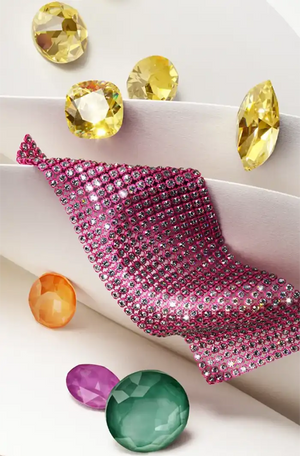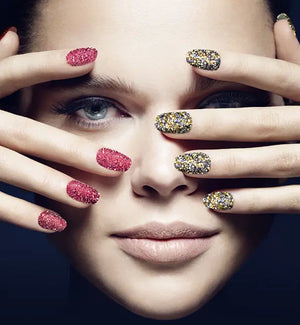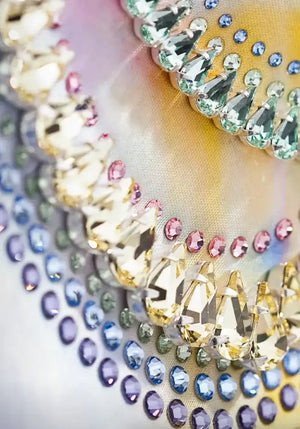
Swarovski Crystals vs Rhinestones
When it comes to adding the perfect finishing touch to any outfit or design project, you can’t go wrong with crystals. But not all crystals are created equal; and when it comes to sparkling brilliance, nothing beats the superior craftsmanship of Swarovski crystals and rhinestones.
That being said, many clothing and jewellery manufacturers prefer to opt for non-branded rhinestones, which are cheaper, often less brilliant in appearance, and often made with acrylics and plastics. But when it comes to Swarovski Crystals vs Rhinestones, which is better? In the following blog, we're going to compare original Swarovski Crystals with common rhinestones, while also giving you some tips and tricks on spotting authentic Swarovski crystals from cheaper imitation pieces. Let's take a look!
What are Swarovski crystals?
In 1895, Daniel Swarovski created the iconic Swarovski crystal, a diamond imitation made with quartz, sand, and minerals to produce a reflective, light-refracting, diamond-like stone. While lead was once used in Swarovski’s crystals to add and enhance refractive shine, the brand went lead-free in 2012.
Swarovski crystals are commonly used in jewellery, but can equally be used in other crafts and designs, such as home furnishings, clothing, nails, and even cars!
What are rhinestones?
Rhinestones are a form of diamond simulant and were originally made with quartz stones found in the Rhine River in Austria. However, as the supply of quartz stones depleted over time, rhinestone manufacturers began using materials such as acrylic and plastics to recreate the Rhinestone look. Over time, the market was flooded with poorly-made, cheap and imitation rhinestones that were often used to decorate clothing and jewellery.
Today, manufacturers should only opt for high-quality rhinestones, such as those by Swarovski, Preciosa, Estella Crystals and Serinity.
What's the difference between Swarovski crystals and rhinestones?
One of the key differences between Swarovski crystals and common rhinestones is the superior manufacturing method, as well as the number of facets on a Swarovski crystal: Swarovski crystals are crafted with superior materials and made with carefully cut facets that produce a more brilliant shine than many other diamond simulants. Secondly, the precision cutting of Swarovski crystals creates a higher refractive index, making them sparkle much brighter than plastic or acrylic rhinestones.
In addition to this, Swarovski crystals are much more durable and resistant to scratching, which makes them a better choice for luxury jewellery; inauthentic rhinestones fade and scratch easily, and aren't designed for long-term pieces. Even while other glass-cutting brands do offer high-quality rhinestones, Swarovski crystals are world-leading when it comes to colour variety, sparkle, range and colour consistency.
There are also some key differences when it comes to how crystals and rhinestones are applied to clothing and other materials; Swarovski offers two different types of flatback crystals for manufacturers: Swarovski flatback rhinestones crystals (Non Hotfix), as well as Hotfix flatback crystals that come with a heat-sensitive glue that has been pre-applied to the underside.
The Hotfix glue used by Swarovski is highly adhesive, meaning that the crystals can stay in place even after years of wear - consider Marilyn Monroe’s iconic dress from 1962! Non-branded rhinestones, on the other hand, are often applied to clothing and jewellery items using weaker glue, and are more prone to becoming dislodged and falling off.
How to tell the difference between Swarovski crystals and rhinestones
So if you’ve recently bought a piece of vintage jewellery (or even a crystal-embellished top) and want to know if you’re in possession of an authentic Swarovski piece, how can you tell? Here are some things to look out for:
Precision cutting
Swarovski is globally renowned for its precise cutting methods, which makes it easy to identify a real Swarovski crystal from a rhinestone imitation. Swarovski crystals are entirely uniform in size, whereas cheaply-made rhinestones can be easily identified by their irregularly-cut shapes.
Bubble and scratch-free surface
Imitation rhinestones are prone to bubbles on the surface, as well as scratches that can detract from their sparkle. It's virtually impossible for bubbles to form on a Swarovski crystal, so this can be a good indicator that your piece might not be the real deal.
Weight
Swarovski crystals are made with heavier materials, such as quartz and minerals, so they tend to be much weightier than rhinestones, especially imitations made with plastic and acrylics. If you’re able to compare the two side-by-side, it can help you detect the difference between a rhinestone and a genuine Swarovski piece.






